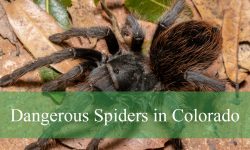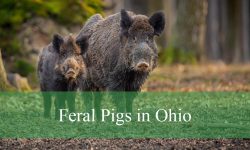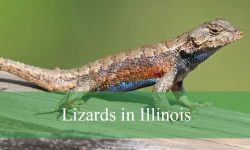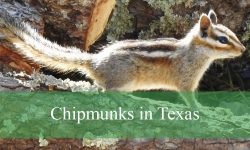Idaho’s forests and open woodlands are alive with the rhythmic drumming of woodpeckers. These fascinating birds play a vital role in maintaining healthy ecosystems by controlling insect populations, creating nesting cavities, and even helping other species thrive. With their striking plumage and unique behaviors, woodpeckers are among the most exciting birds to observe in the Gem State.
The state is home to an impressive 11 species of woodpeckers, ranging from the tiny Downy Woodpecker to the majestic Pileated Woodpecker. Each species has its own preferred habitat, feeding style, and seasonal behavior, making Idaho a prime destination for birdwatchers hoping to spot a variety of woodpeckers throughout the year.
Whether you explore riparian corridors, ponderosa pine forests, or high-elevation spruce stands, you’re bound to encounter these remarkable birds. This guide will help you identify and understand the different woodpecker species in Idaho, complete with detailed descriptions, habitats, and the best times to see them.
Types of Woodpeckers Found in Idaho
Downy Woodpecker (Dryobates pubescens)

The Downy Woodpecker is the smallest woodpecker in Idaho, measuring about 6 to 7 inches long. It has a compact body, a short beak compared to other woodpeckers, and distinctive black-and-white plumage. Males show a small red patch on the back of the head, while females lack this marking. Their crisp black wings with white spots and clean white underparts make them easy to identify.
In Idaho, Downy Woodpeckers can be spotted in woodlands, orchards, suburban yards, and parks. They are common year-round residents, thriving in areas with a mix of trees and open spaces. Their drumming sound is often heard during spring as part of their courtship behavior.
These birds feed mainly on insects such as beetle larvae, ants, and caterpillars, often pecking at tree bark to uncover prey. They also eat berries and seeds, especially in winter when insects are scarce. At backyard feeders, they readily come for suet, sunflower seeds, and peanuts.
Downy Woodpeckers play an important ecological role by helping control insect populations. Their adaptability to natural and human-modified landscapes makes them one of the most familiar woodpeckers in the state.
Hairy Woodpecker (Dryobates villosus)
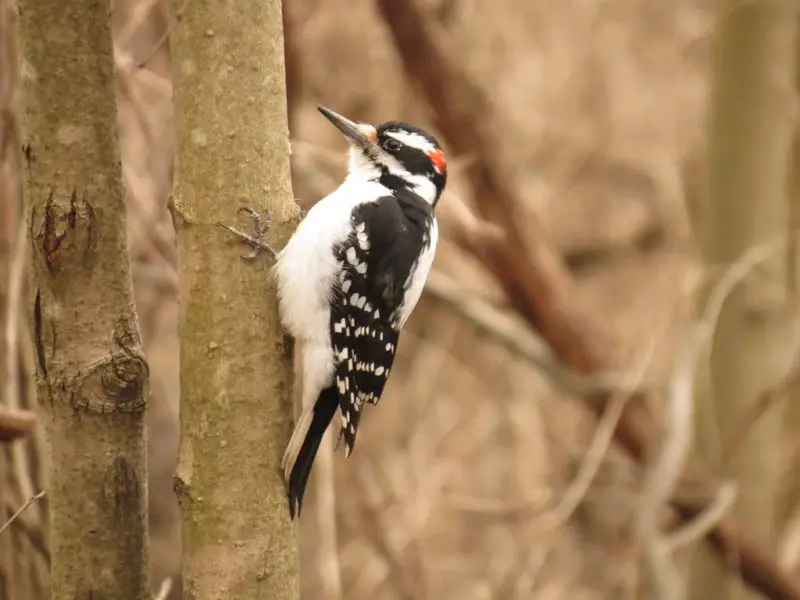
The Hairy Woodpecker looks nearly identical to the Downy but is noticeably larger, reaching about 9 to 10 inches long. Its bill is longer and more chisel-like, about the same length as its head, which helps in distinguishing it from the smaller Downy. Both sexes share black-and-white plumage, but males display a red patch at the back of the head.
In Idaho, Hairy Woodpeckers live in mature forests, woodlots, riparian zones, and even city parks with older trees. They are permanent residents across the state and are especially associated with large conifers and mixed woodlands.
Their diet is mainly composed of wood-boring insects, beetles, and larvae, which they extract from deep inside tree trunks. They also consume seeds, nuts, and occasionally sap. Like their smaller cousins, they often visit suet feeders in winter.
Hairy Woodpeckers serve as excellent indicators of healthy forests because they rely on mature trees for foraging and nesting. Birdwatchers in Idaho often see them alongside Downy Woodpeckers, but their larger size and longer bill give them away.
Northern Flicker (Colaptes auratus)
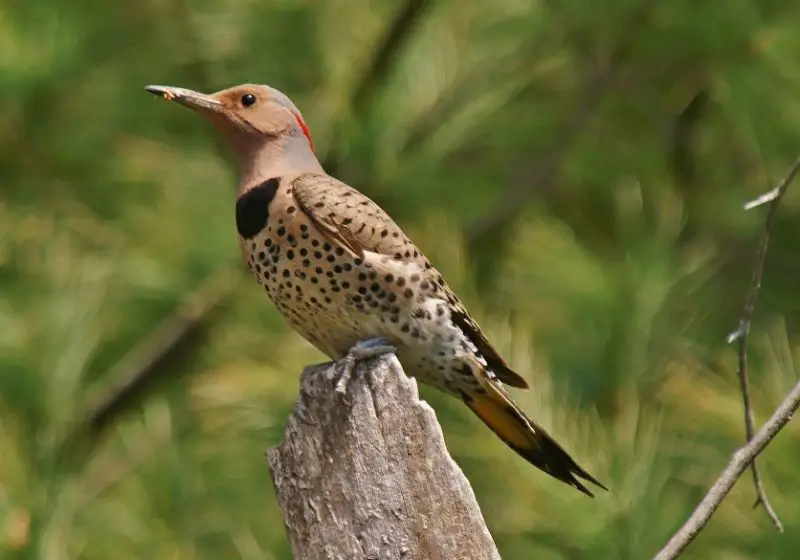
The Northern Flicker is one of the most striking and widespread woodpeckers in Idaho. Unlike most woodpeckers, flickers often forage on the ground, probing the soil for ants, which make up a large portion of their diet. They are medium-large birds, about 12 inches long, with brown plumage patterned with black bars and spots.
In Idaho, two main forms are present: the Red-shafted Flicker, with red underwings and tail feathers, and occasionally hybrids with the Yellow-shafted Flicker. Both display a black crescent on the chest and white rump visible in flight. Males often have a red mustache-like mark on the face.
These birds can be found in open woodlands, forest edges, and even suburban backyards. They drum loudly on trees, metal poles, or rooftops to mark territory during spring. Their distinctive “wick-a-wick-a-wick” call is one of the most recognizable woodpecker sounds.
Northern Flickers provide valuable ecological benefits by controlling ant and beetle populations. Their adaptability allows them to thrive across Idaho, from dry grasslands with scattered trees to higher elevation forests.
Red-naped Sapsucker (Sphyrapicus nuchalis)
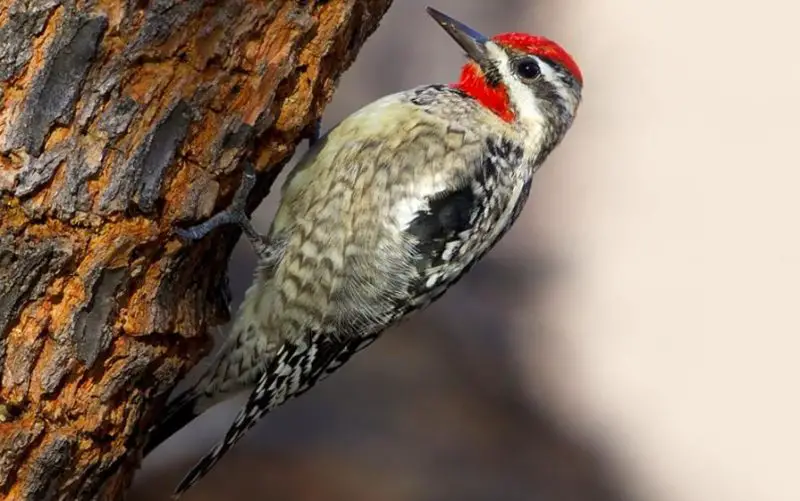
The Red-naped Sapsucker is a medium-sized woodpecker, about 7 to 8 inches long, easily identified by its striking red crown and nape, white vertical wing stripe, and black-and-white face pattern. Both sexes share similar plumage, though males tend to have more extensive red on the throat.
In Idaho, these woodpeckers breed in aspen groves, mixed forests, and riparian corridors where deciduous trees are abundant. They are more common in central and northern parts of the state during the breeding season but migrate southward in winter.
True to their name, Red-naped Sapsuckers drill neat rows of holes in tree bark to feed on sap. They also consume insects attracted to the sap and will eat fruit and berries when available. This feeding behavior can sometimes cause stress to trees, but it also benefits other animals that feed on the sap.
These woodpeckers are crucial contributors to forest ecosystems, as their sap wells provide food for hummingbirds, bats, and other insects. Their presence in Idaho highlights the importance of healthy aspen and riparian habitats.
Williamson’s Sapsucker (Sphyrapicus thyroideus)
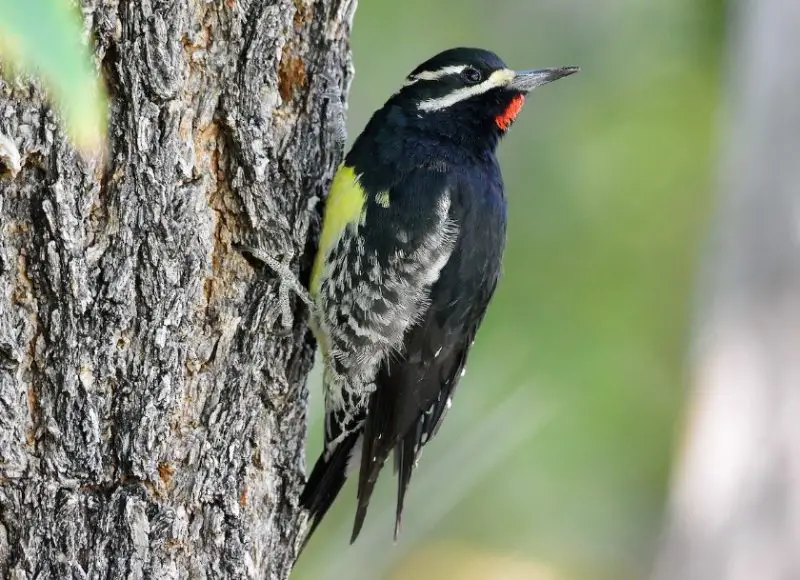
Williamson’s Sapsucker is one of the more unusual and less commonly seen woodpeckers in Idaho. Males and females look very different, a trait known as sexual dimorphism. Males are mostly black with a bright yellow belly and a striking red throat, while females are barred brown and white, resembling a different species altogether.
In Idaho, Williamson’s Sapsuckers are found in higher-elevation coniferous forests, especially in areas dominated by pines and firs. They prefer mature trees for nesting and feeding, making them more restricted in range compared to other woodpeckers.
Their diet consists largely of tree sap, ants, beetles, and other insects. They drill small holes into trunks of living conifers to lap up sap, which also attracts a variety of insects. This makes them important contributors to the forest food web.
Because of their preference for high-altitude conifer forests, Williamson’s Sapsuckers are less frequently seen than Red-naped Sapsuckers or Northern Flickers. However, patient birders in Idaho’s mountains can often spot them during the summer breeding season.
Red-breasted Sapsucker (Sphyrapicus ruber)

The Red-breasted Sapsucker is a medium-sized woodpecker with striking colors that make it easy to identify. It has a deep red head and breast, a white belly, and black wings with white spotting. Unlike the Red-naped Sapsucker, which shows a red patch only on the crown and nape, the Red-breasted has a more extensive red wash covering much of its head and chest. This vibrant plumage stands out against the forest backdrop of Idaho’s woodlands.
In Idaho, the Red-breasted Sapsucker is found primarily in the northern and central regions. It prefers mixed coniferous and deciduous forests, especially areas with aspens and willows near streams or wetlands. While some individuals remain year-round, many migrate southward to the Pacific Coast during the colder months.
As a true sapsucker, this species drills rows of holes in tree bark to feed on sap. It also consumes insects trapped in the sticky fluid and supplements its diet with berries and fruit when available. This feeding strategy can cause stress to host trees but simultaneously supports a diverse group of wildlife that take advantage of the sap wells.
The Red-breasted Sapsucker plays an essential role in Idaho’s forest ecosystems. Its sap wells provide nourishment for hummingbirds, warblers, and even small mammals, making it a keystone species in areas where it occurs. Birdwatchers in Idaho are often thrilled to spot this brilliantly colored woodpecker in riparian corridors and forest edges.
Lewis’s Woodpecker (Melanerpes lewis)

Lewis’s Woodpecker is unlike most woodpeckers in both appearance and behavior. It has a dark greenish-black back, a pinkish belly, and a red face, with broad wings that allow for graceful, crow-like flight. Instead of clinging to tree trunks and pecking continuously, Lewis’s Woodpecker often catches insects in midair, giving it a unique place among Idaho’s woodpeckers.
This species is found in open pine forests, oak woodlands, and areas with scattered trees and snags. In Idaho, they are most common in the western and southern regions, particularly in ponderosa pine habitats. They migrate more than many other woodpeckers, often moving south during winter, though some remain in milder parts of the state.
Lewis’s Woodpeckers feed on flying insects during summer, making them expert aerial hunters. In fall and winter, their diet shifts toward acorns, nuts, and fruits. They are known to store acorns in tree crevices, much like jays or nuthatches, creating food reserves for the colder months.
Because of their reliance on specific habitats, especially ponderosa pine forests, Lewis’s Woodpeckers are considered vulnerable to habitat loss. Protecting open forest areas with standing dead trees is vital to ensuring their continued presence in Idaho.
American Three-toed Woodpecker (Picoides dorsalis)
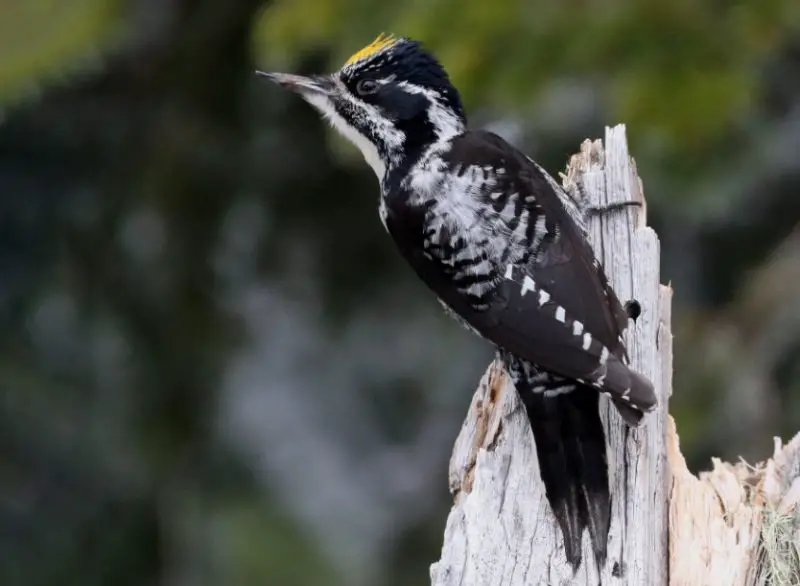
The American Three-toed Woodpecker is a small, specialized species adapted to boreal and montane forests. Unlike most woodpeckers, it has only three toes instead of four, which aids in clinging tightly to tree bark. Its plumage is mostly black and white, with a barred back and flanks, and males show a yellow crown patch that adds a splash of color.
In Idaho, this species is most often found in northern and central forests at higher elevations. They prefer spruce and fir forests, especially areas affected by bark beetle outbreaks or fire damage, since these provide an abundance of insect prey. They are year-round residents, though their populations fluctuate depending on forest conditions.
These woodpeckers feed primarily on wood-boring beetle larvae and other insects hidden beneath bark. They use their strong bills to flake off bark rather than drill deep holes, making their foraging style distinctive. Their reliance on insect outbreaks means their populations can rise in areas where beetle activity is high.
The American Three-toed Woodpecker is an important indicator of forest health. Because they thrive in disturbed forests, their presence often signals recent changes such as fires or beetle infestations. For birders in Idaho, spotting one is a rewarding experience, as they are less common and more elusive than other woodpeckers.
Black-backed Woodpecker (Picoides arcticus)

The Black-backed Woodpecker is another specialist species in Idaho, closely associated with recently burned forests. As its name suggests, it has an entirely black back, which provides camouflage against charred tree trunks. The underparts are white with fine barring on the sides, and males carry a small yellow crown patch.
This bird is found in northern and central Idaho, particularly in coniferous forests that have recently experienced wildfire. Burned trees harbor large populations of wood-boring beetles, providing the perfect food source for this woodpecker. Unlike many other species, it often disappears once the forest begins to regenerate.
Its diet consists almost exclusively of beetle larvae, which it extracts by scaling bark from dead or dying trees. This feeding behavior helps regulate insect outbreaks and contributes to the natural recovery of burned forests. Unlike sapsuckers, it rarely consumes fruit or sap.
The Black-backed Woodpecker is a fire-dependent species, meaning its population rises and falls with forest fire cycles. In Idaho, forest managers consider it an important species for monitoring the health and regeneration of fire-affected ecosystems. Birdwatchers often seek them out in freshly burned areas where their activity is most pronounced.
White-headed Woodpecker (Dryobates albolarvatus)

The White-headed Woodpecker is one of Idaho’s most striking and easily recognized woodpeckers. Its body is entirely black with a pure white head, making it stand out dramatically in the forest. Males also have a small red patch on the back of the head, while females lack this marking.
In Idaho, this species is mostly restricted to dry pine forests, especially those dominated by ponderosa and Jeffrey pines. They are year-round residents in the state’s mountainous and forested regions, but their range is limited, making them less commonly seen than other woodpeckers.
Unlike many woodpeckers that rely heavily on insects, White-headed Woodpeckers specialize in feeding on pine seeds. They also eat insects gleaned from bark and occasionally visit feeders for suet. Their dependence on mature pine forests means they are closely tied to the availability of healthy pine stands.
The White-headed Woodpecker is considered a sensitive species due to habitat loss and logging of mature pine forests. In Idaho, conserving old-growth pine habitats is essential to maintaining their populations. For bird enthusiasts, spotting one of these unique woodpeckers is a highlight of any forest outing.
Pileated Woodpecker (Dryocopus pileatus)
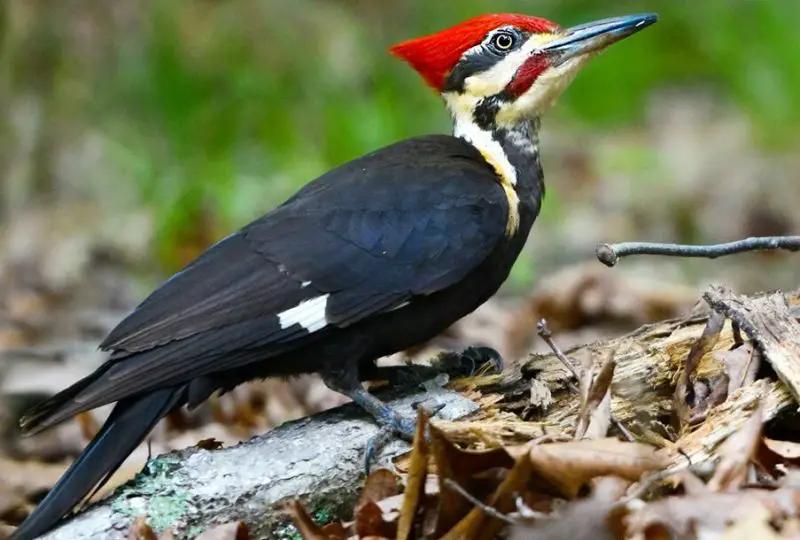
The Pileated Woodpecker is the largest woodpecker in Idaho and one of the most impressive birds in North America. Measuring up to 19 inches long with a wingspan of nearly 30 inches, it has a black body, bold white stripes along the neck, and a brilliant red crest. Its loud, maniacal call and powerful drumming are unmistakable in the forest.
In Idaho, Pileated Woodpeckers inhabit mature forests with large standing dead trees. They are permanent residents, though they require extensive forest tracts to thrive. They are most commonly seen in northern and central Idaho, where old-growth forests remain intact.
Their diet is dominated by carpenter ants and wood-boring beetles, which they excavate from deep within tree trunks using powerful blows. The large rectangular holes they create in trees are distinctive and provide shelter for many other animals, including owls, ducks, bats, and small mammals.
The Pileated Woodpecker is often seen as a symbol of healthy forest ecosystems. Its presence in Idaho underscores the importance of conserving mature forests with abundant deadwood. For many birdwatchers, encountering this majestic woodpecker is a once-in-a-lifetime experience that leaves a lasting impression.
Best Time and Places to See Woodpeckers in Idaho
Idaho’s woodpeckers can be seen year-round, but the best time to observe them is during spring and early summer when they are most active in courtship and nesting. From March through June, woodpeckers drum loudly on trees, poles, and even metal objects to mark territory and attract mates. This makes them easier to locate by sound, even before you spot them visually. Winter is also a good time, especially at feeders stocked with suet, peanuts, or sunflower seeds.
The best places to observe woodpeckers in Idaho depend on the species. For common species such as the Downy and Hairy Woodpeckers, suburban yards, city parks, and riparian forests are excellent locations. Northern Flickers are often seen in open woodlands and grasslands with scattered trees. Higher-elevation conifer forests, particularly in central and northern Idaho, are home to more specialized species like the American Three-toed and Black-backed Woodpeckers.
For birdwatchers seeking rare or striking species, specific habitats are key. White-headed and Lewis’s Woodpeckers are best found in ponderosa pine forests, while Pileated Woodpeckers prefer large, mature forests with abundant dead trees. Red-naped and Red-breasted Sapsuckers thrive in aspen groves and riparian corridors. Visiting national forests, state parks, and designated birding trails increases the chances of observing these fascinating birds.
Exploring areas such as Boise National Forest, Clearwater National Forest, and Sawtooth National Forest provides some of the best opportunities to see a wide range of woodpecker species in Idaho. Early morning walks with binoculars in hand are the most rewarding, as woodpeckers are especially active during the first few hours of daylight.
FAQs About Woodpeckers in Idaho
How many types of woodpeckers live in Idaho?
Idaho is home to 11 species of woodpeckers, ranging from the small Downy Woodpecker to the large Pileated Woodpecker. Some, like the Northern Flicker and Hairy Woodpecker, are widespread, while others, such as the Black-backed and White-headed Woodpeckers, are more specialized and limited in range.
Do woodpeckers stay in Idaho year-round?
Yes, many species of woodpeckers, including the Downy, Hairy, and Pileated, are permanent residents in Idaho. However, some species, such as Red-naped and Williamson’s Sapsuckers, migrate southward in winter, returning to Idaho during the breeding season.
What do woodpeckers eat in Idaho?
Woodpeckers feed mainly on insects, especially ants, beetles, and larvae hidden beneath tree bark. Some species, like sapsuckers, also feed on tree sap, fruit, and berries. In winter, woodpeckers may visit feeders for suet, nuts, and seeds, making them easier to observe in backyards.
Are woodpeckers harmful to trees in Idaho?
Most woodpecker activity is beneficial since they control insect populations that harm trees. However, sapsuckers can sometimes stress trees by drilling rows of sap wells. While this may cause localized damage, it usually does not kill healthy trees and provides food for other wildlife.
Where is the best place to see Pileated Woodpeckers in Idaho?
Pileated Woodpeckers prefer mature forests with large standing dead trees. In Idaho, they are most often found in northern and central forests, including areas like Clearwater National Forest and parts of the Sawtooth Mountains. Their loud drumming and distinctive calls help birders locate them in dense woodlands.


